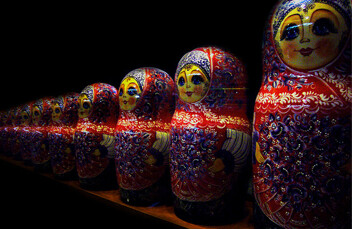One consistent point in Vice President Joe Biden's rhetoric over the past year, from the Munich security conference in February to his October address in Bucharest, is that the United States refuses to countenance any sort of Russian "sphere of influence" in its "near abroad." From a political point of view, this is an entirely justifiable concern. Yet, nearly two decades after the collapse of the Soviet Union, the United States must confront the reality that Eurasia remains a very Russia-centric region.
Not only is Russia the region's dominant military power, it is also the leading economic and cultural hub. Russia accounts for nearly 74 percent of the region's GDP. Some of this is certainly due to high prices for energy and other natural resources. But it also reflects the reality that much of the Soviet Union's industrial base and natural resource endowment at the time of its collapse was contained within the boundaries of Russia.
Part of the uptick in Russia's own GDP has been growth of its trade and economic relations with other former Soviet states, as well as the process of economic reintegration, particularly between Russia and Kazakhstan. When one examines travel and transport routes, Moscow remains the principal hub connecting the states of Eurasia with each other and, in many cases, with the outside world as well.
Moreover, despite inroads made by English, Russian remains the lingua franca of commerce and diplomacy throughout most of the region, if not the native language of many who live outside Russia. Indeed, the countries of the former Soviet Union have many of the building blocks of what James Bennett terms a network commonwealth—a series of ad hoc economic, cultural, and political arrangements that tie together countries sharing a common language, values, and outlook.
The collapse of the Soviet Union brought about political disintegration, but did little to interrupt established Soviet-era patterns of interaction, from industrial trade to rail travel and ground transportation. As an editorial in Holos Ukrainy (December 4, 2001) plainly stated: "Moscow will not go anywhere. The old debts and old links that determine mutual dependence will stay." This is true for commercial exchange as well as cultural interchange, ranging from pop culture to the media and education.
This is partly attributable to the continuity of established social networks, but also to the emergence of new networks along established lines of interaction and communication. So, while the old Komsomol networks may be defunct, a network of politically motivated youths, often attached to the youth wings of the major parties, has emerged to fill this gap. Likewise, networks of businessmen and even lay believers have emerged where before there were networks of state industry executives and Znanie society members. New highways of exchange are emerging along well-trodden paths.
The cultural tendency toward this sort of networking and exchange—which the Soviet system inadvertently encouraged—is an obstacle to post-Soviet societies developing strong ties with countries outside the Eurasian space. Post-Soviet citizens have developed their own way of doing business which outsiders can find hard to handle. And as Eurasian states begin to increase integration—such as the move to establish a Customs Union and common economic space between Russia, Belarus, and Kazakhstan—these tendencies are augmented.
Already, Russian investment is greatest in Belarus, Kazakhstan, Azerbaijan, Ukraine, Moldova, Armenia, and Georgia. Kazakhstan itself accounts for nearly one half of Russian foreign direct investment in the former Soviet states, while Azerbaijan and Ukraine each account for another twenty percent. When investments from Cyprus, the British Virgin Islands, and other offshore accounts are included, Russian investment is even higher, with Russia becoming the single largest investor in Ukraine.
When one looks at the flow of goods and services, the ties between Russia and her neighbors are reinforced. Russia is the principal source for imports and exports for Ukraine, Belarus, Moldova, Armenia, Uzbekistan, and Kyrgyzstan. Even for those Eurasian states that have forged new trading links—such as Georgia, borne of the necessity of various embargoes and then the 2008 war—Russia still remains a prominent trading partner.
And while the trade and economic interaction between Russia and Europe remains of critical importance to Moscow, the "new story" in terms of overall trade patterns within Eurasia is the emergence of two new important players—China and Turkey. In other words, it is not the United States or Western Europe moving into the region to displace Russia, but two other countries that also enjoy renewed friendly relations with Moscow. This confirms what Steven Weber and his colleagues at the University of California at Berkeley have observed, that the rate of economic and political interconnection is growing much faster within what they term "the World without the West" than between the West and everyone else.
So, despite the predictions that the collapse of the Soviet Union would lead to the emergence of very distinct regions—a Central Asia tied to Turkey and China, a Caucasus connected to Southern Europe, and a western periphery integrated into Europe—a Russian-led Eurasia still exists as a distinct entity in the early twenty-first century. Just as Mexico laments that it is "so far from God, so close to the United States," it is quite understandable that many of Russia's neighbors wish they could have a much greater degree of separation from Moscow, especially those forcibly incorporated into the Soviet Union after varying experiences of independence between the world wars.
But barring fantasies about the complete disintegration of Russia as a state, Russia will continue to be a major factor in their deliberations. Contrary to predictions about the "end of Eurasia," a distinct global region will continue to exist for the foreseeable future between the European Union in one direction and a Chinese-dominated East Asia in the other, especially in terms of business.
Christopher Marsh is the director of the Institute for Church-State Studies at Baylor University. Nikolas K. Gvosdev is a professor of national security studies at the U.S. Naval War College. This essay reflects the personal views of the authors.





